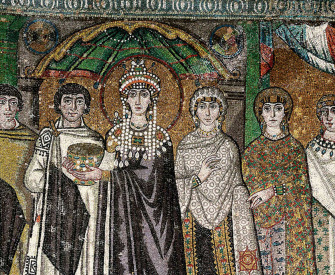Abdullah ibn Yazid relates that he saw the houses in which the wives of the Prophet dwelled at the time when the governor of Medina demolished them.
They were built of unburned bricks and had separate apartments made of palm branches, daubed with mud. He counted nine houses. Each was three cubits in length, with leather curtains or draped black hair for the doors. A person could reach the roof with the hand. Observing the dwelling place of Muhammad’s wife Umm Salama, Ibn Yazid questioned her grandson, who told him that when the Prophet was absent on an expedition, Umm Salama built up an addition to her house with a wall of unburned bricks. When Muhammad returned, he went in to her and asked what new building this was. She replied, “O Prophet, I wanted to prevent people looking in!” Muhammad answered, “O, Umm Salama, the most iniquitous thing is the wealth of Muslims going into buildings.”
A citizen of Medina was present when the dispatch was read aloud that commanded these houses should be torn down and moved within the area of the mosque. He said he never witnessed sorer weeping than there was among the people that day. One wife exclaimed, “I wish, by the Lord, that they would leave these houses alone. Then would those that spring up hereafter in Medina, and strangers from the ends of the earth, come and see what kind of building sufficed for the Prophet’s own abode, and the sight thereof would deter men from extravagance and pride.”
The house of Muhammad’s companion Zayd ibn Haritha was next to that of the Prophet. Now, whenever Muhammad took to himself a new wife, he added another house to the row, and Ibn Haritha was obliged successively to remove his house and to build on the space beyond. At last this was repeated so often that the Prophet said about him, “Truly, it shames me to turn Ibn Haritha over and over again out of his house.”
From Book of the Major Classes. Born in Basra in 784, Ibn Saʿd worked as the scribe of al-Waqidi, a well-known historian of the period. His collection of biographies about early Islamic personalities became obscure after his death in 845 but was revised several centuries later and gained popularity as a canonical Sunni work. Ibn Haritha, constantly uprooted from his home, is the only companion of the Prophet mentioned by name in the Qur’an.
Back to Issue



